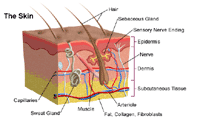How Long Do 3rd Degree Burns Take to Heal
A third-degree burn is referred to as a full thickness burn. This type of burn destroys the outer layer of skin (epidermis) and the entire layer beneath (the dermis).

In most cases, full thickness, third-degree burns are caused by the following:
-
A scalding liquid
-
Skin that comes in contact with a hot object for an extended period of time
-
Flames from a fire
-
An electrical source
-
A chemical source
The following are the most common symptoms of a full thickness, third-degree burn. However, each child may experience symptoms differently. Symptoms may include:
-
Dry and leathery skin
-
Black, white, brown, or yellow skin
-
Swelling
-
Lack of pain because nerve endings have been destroyed
Large, full thickness, third-degree burns heal slowly and poorly without medical attention. Because the epidermis and hair follicles are destroyed, new skin will not grow.
The symptoms of a third-degree burn may resemble other conditions or medical problems. Consult your child's physician for a diagnosis. Third degree burns should always be evaluated immediately in the emergency department. They may require transfer to a burn center for further treatment.
Specific treatment for a full thickness third-degree burn will be determined by your child's doctor, based on the following:
-
Your child's age, overall health, and medical history
-
Extent of the burn
-
Location of the burn
-
Cause of the burn
-
Your child's tolerance for specific medications, procedures, or therapies
-
Your opinion or preference
Treatment for full thickness, third-degree burns will depend on the severity of the burn. Burn severity is determined by the amount of body surface area that has been affected. The burn severity will be determined by your child's doctor. Treatment for third-degree burns may include the following:
-
Early cleaning and debriding (removing dead skin and tissue from the burned area). This procedure can be done in a special bathtub in the hospital or as a surgical procedure.
-
Intravenous (IV) fluids containing electrolytes
-
Intravenous (IV) or oral antibiotics if your child develops an infection
-
Antibiotic ointments or creams
-
A warm, humid environment for the burn
-
Nutritional supplements and a high-protein diet
-
Pain medications
-
Skin grafting (may be required to achieve closure of the wounded area)
-
Functional and cosmetic reconstruction
-
Tetanus shot
A skin graft is a piece of the child's unburned skin which is surgically removed to cover a burned area. Skin grafts can be thin or thick. Skin grafts are performed in the operating room. The burn that is covered with a skin graft is called a graft site.
The area where the piece of unburned skin was taken to be donated to a burned area is called a donor site. After a skin graft procedure, the donor sites look like a scraped or skinned knee. Your child's doctor will decide if a skin graft is needed. A skin graft is often performed after debridement or removal of the dead skin and tissue.
A dressing is left on the graft site for two to five days before it is changed, so that the new skin will stay in place. For the first several days, graft sites need to be kept very still and protected from rubbing or pressure.
The donor site is covered for the first one to two weeks. The site needs to be kept covered. Donor sites usually heal in 10 to 14 days. If a dressing is applied, it usually remains on until it comes off by itself. Lotion is applied to the donor site after the dressing comes off. This skin often flakes off and looks dry.
How Long Do 3rd Degree Burns Take to Heal
Source: https://www.chop.edu/conditions-diseases/third-degree-burns